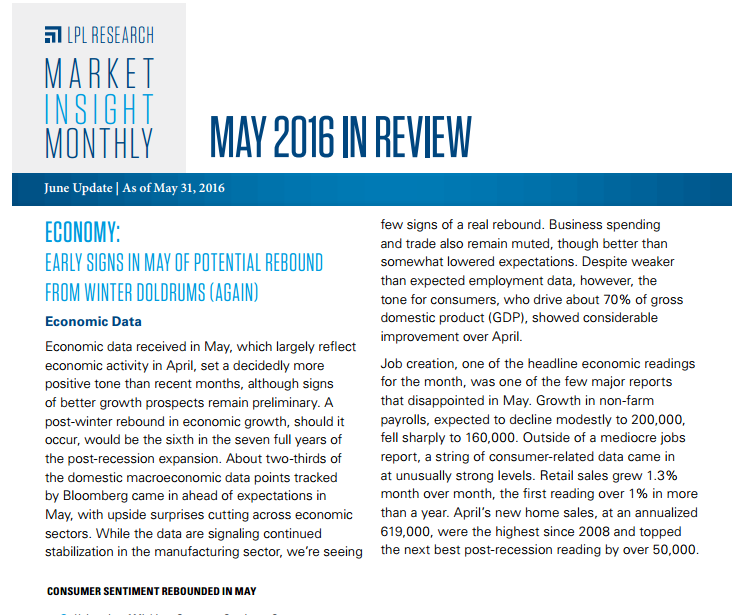ECONOMY: EARLY SIGNS IN MAY OF POTENTIAL REBOUND FROM WINTER DOLDRUMS (AGAIN)
Click here to download a PDF of this report.
Economic Data
Economic data received in May, which largely reflect economic activity in April, set a decidedly more positive tone than recent months, although signs of better growth prospects remain preliminary. A post-winter rebound in economic growth, should it occur, would be the sixth in the seven full years of the post-recession expansion. About two-thirds of the domestic macroeconomic data points tracked by Bloomberg came in ahead of expectations in May, with upside surprises cutting across economic sectors. While the data are signaling continued stabilization in the manufacturing sector, we’re seeing few signs of a real rebound. Business spending and trade also remain muted, though better than somewhat lowered expectations. Despite weaker than expected employment data, however, the tone for consumers, who drive about 70% of gross domestic product (GDP), showed considerable improvement over April.
Job creation, one of the headline economic readings for the month, was one of the few major reports that disappointed in May. Growth in non-farm payrolls, expected to decline modestly to 200,000, fell sharply to 160,000. Outside of a mediocre jobs report, a string of consumer-related data came in at unusually strong levels. Retail sales grew 1.3% month over month, the first reading over 1% in more than a year. April’s new home sales, at an annualized 619,000, were the highest since 2008 and topped the next best post-recession reading by over 50,000.

The pickup in consumer-driven economic activity was reflected in improving consumer sentiment following early year recession concerns. The University of Michigan Consumer Sentiment Survey advanced solidly to approach the upper end of its postrecession range.
On the industry side, recent stabilization continued but with little to indicate additional acceleration. The Institute for Supply Management’s (ISM) manufacturing Purchasing Managers’ Index (PMI) retreated from 51.8 to 50.8, missing consensus expectations (above 50 indicates expansion). New export orders held steady at 52.5, offering some evidence that headwinds from a strong dollar may be abating. Factory orders (March) and industrial production (April) both posted small upside surprises and exhibited growth after contracting in the April releases. The services sector remains more robust with the ISM’s non-manufacturing composite, at 55.7, both topping expectations and accelerating from the prior month.
Real time and leading indicators continue to point to a declining chance of recession in the next year. Financial stress, as measured by the St. Louis Fed’s Financial Stress Index, fell for the third consecutive month and has retreated to its lowest level since August of last year. The Conference Board’s Leading Economic Index (LEI), an aggregate of leading indicators, topped expectations and has risen 1.9% year over year. Historically, a negative year-over-year rate indicates increased likelihood of recession in the next 6–18 months, and at current levels a signal remains unlikely over the next several months. Meanwhile, the Atlanta Fed’s real-time GDP forecasting model saw its second quarter GDP forecast rise from 1.8% at the end of April to 2.9% at the end of May, driven primarily by forecast improvements from consumer goods expenditures and home building.

Central Banks
The May 18 release of the minutes from the Federal Reserve’s (Fed) April 26–27, 2016 policy meeting caused a meaningful shift in market expectations of future Fed rate hikes. The release of the minutes is usually a non-event, as market participants already have the policy statement (released post-meeting), and Fed members have already made a series of post-meeting speeches. However, markets had remained skeptical of Fed projections of two rate hikes by the end of the year. The minutes, however, reinforced what Fed members have been emphasizing in speeches by explicitly stating that a hike in June was still on the table for “most participants,” assuming continued economic data support. The market’s immediate response was a substantial shift in rate hike expectations, as measured by fed fund futures, accompanied by a stronger dollar and a sharp one-day spike in Treasury yields. The Fed will meet again on June 14–15.
